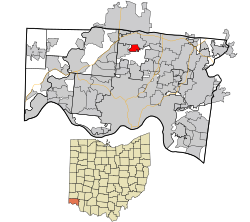2020 census
As of the census of 2020, there were 3,741 people living in the village, for a population density of 3,007.23 people per square mile (1,160.88/km2). There were 1,618 housing units. The racial makeup of the village was 73.2% White, 15.0% Black or African American, 0.2% Native American, 0.9% Asian, 0.0% Pacific Islander, 2.2% from some other race, and 8.5% from two or more races. 5.0% of the population were Hispanic or Latino of any race. [19]
There were 1,409 households, out of which 33.6% had children under the age of 18 living with them, 35.6% were married couples living together, 17.9% had a male householder with no spouse present, and 36.3% had a female householder with no spouse present. 33.2% of all households were made up of individuals, and 10.8% were someone living alone who was 65 years of age or older. The average household size was 2.58, and the average family size was 3.39. [19]
28.4% of the village's population were under the age of 18, 57.6% were 18 to 64, and 14.0% were 65 years of age or older. The median age was 37.8. For every 100 females, there were 104.8 males. [19]
According to the U.S. Census American Community Survey, for the period 2016-2020 the estimated median annual income for a household in the village was $69,208, and the median income for a family was $80,625. About 10.7% of the population were living below the poverty line, including 14.5% of those under age 18 and 9.0% of those age 65 or over. About 62.0% of the population were employed, and 31.9% had a bachelor's degree or higher. [19]
2010 census
As of the census [20] of 2010, there were 3,615 people, 1,499 households, and 968 families residing in the village. The population density was 2,892.0 inhabitants per square mile (1,116.6/km2). There were 1,645 housing units at an average density of 1,316.0 per square mile (508.1/km2). The racial makeup of the village was 88.0% White, 6.7% African American, 0.1% Native American, 0.8% Asian, 0.1% Pacific Islander, 0.7% from other races, and 3.6% from two or more races. Hispanic or Latino of any race were 2.4% of the population.
There were 1,499 households, of which 30.5% had children under the age of 18 living with them, 46.0% were married couples living together, 14.0% had a female householder with no husband present, 4.6% had a male householder with no wife present, and 35.4% were non-families. 30.3% of all households were made up of individuals, and 9.9% had someone living alone who was 65 years of age or older. The average household size was 2.37 and the average family size was 2.95.
The median age in the village was 39 years. 23.8% of residents were under the age of 18; 7.1% were between the ages of 18 and 24; 26.2% were from 25 to 44; 27% were from 45 to 64; and 16% were 65 years of age or older. The gender makeup of the village was 47.2% male and 52.8% female.



